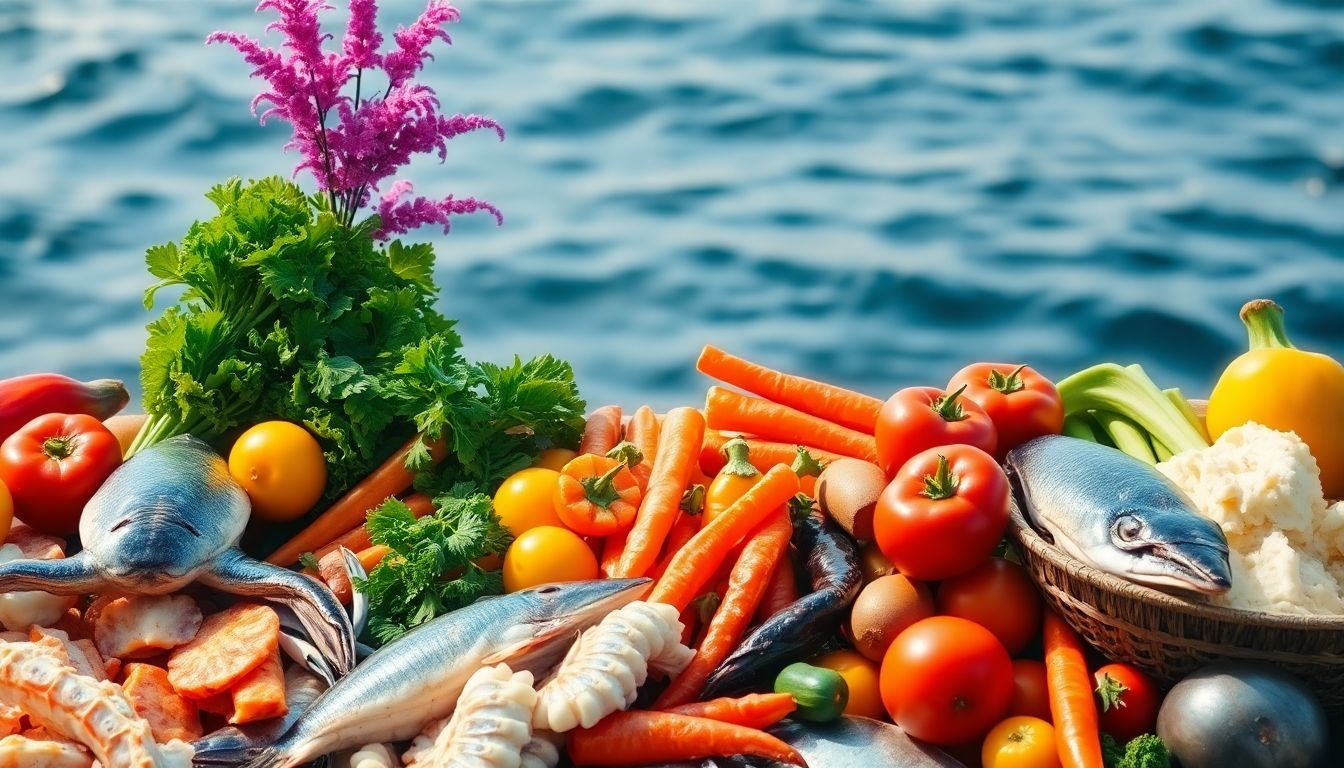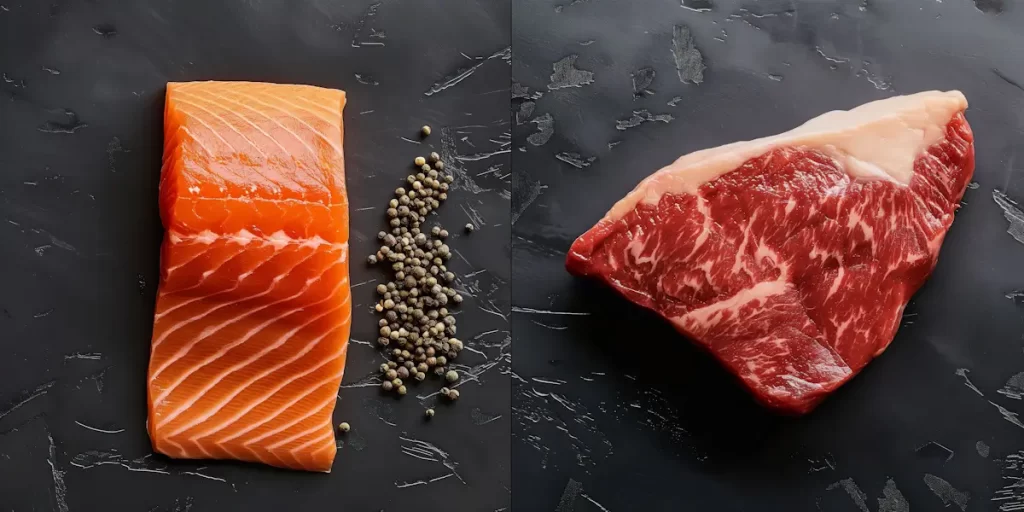Tired of feeling stuck with your current diet? A pescatarian diet focuses on fish, seafood, and plant-based foods while skipping red meat. This guide will show you the benefits, what to eat, and how to start easily.
Thank you for reading this post, don't forget to subscribe!Keep reading—you might just find your new favorite way to eat!
Key Takeaways
- A pescatarian diet includes fish, seafood, whole grains, legumes, fruits, and vegetables while avoiding red meat. It provides omega-3s for heart health and supports weight loss.
- Eating two seafood meals a week can lower the risk of heart disease by up to 9%. Choose grilled or low-mercury options like salmon or sardines for health benefits.
- High-mercury fish like swordfish and king mackerel should be avoided due to potential brain and nerve damage risks. Stick to safe choices like canned salmon or light tuna.
- Nutritional gaps may occur without careful planning. Add fortified foods or supplements to get enough vitamin B12, iron, and zinc in your diet.
- Overfishing impacts marine life; choose sustainable seafood to protect ecosystems while enjoying healthy meals.
Key Benefits of a Pescatarian Diet
A pescatarian diet can boost your health in many ways. It helps your body gain healthy fats and vital nutrients like omega-3s, which support overall well-being.
Supports heart health
Fatty fish like salmon and mackerel are rich in omega-3 fatty acids. These healthy fats reduce inflammation, lower high blood pressure, and improve cardiovascular health. Men who eat more fish have a 9% lower risk of death from heart disease.
Women see an 8% drop.
Eating two seafood meals weekly may cut the chances of stroke, sudden cardiac death, and heart failure. Non-fried options like grilled or baked fish offer the most benefits. Canned sardines or tuna can also be convenient ways to get these nutrients into your diet.
Omega-3s are a powerful tool against heart disease.
Reduces inflammation
Omega-3 fatty acids from fish like salmon, mackerel, and herring lower inflammation in the body. These healthy fats block chemicals that trigger swelling and pain. A pescatarian diet rich in these nutrients may also decrease risks of heart disease and joint problems.
Anti-inflammatory foods like fruits, vegetables, and whole grains, common in this diet, help improve your health further. People following such diets have shown a reduced risk of type 2 diabetes and some cancers.
Choosing nutrient-dense options supports overall wellness—leading perfectly to weight management benefits!
Aids in weight management
Eating lean seafood like cod can help you lose weight. Studies show people on calorie-restricted diets, who ate fish, shed nearly 4 pounds more than those who skipped it. Fish fills you up with fewer calories compared to beef or red meat.
Low-mercury fish and canned salmon are great options for healthy eating. Seafood also helps cut overall calorie intake by 4%–9%. Its low saturated fat content makes it a smart choice for those aiming for weight loss while staying full longer.
Foods to Include in a Pescatarian Diet
A pescatarian diet includes a variety of nutrient-packed options. It focuses on fresh, whole foods that provide lean protein, healthy fats, and essential vitamins.
Fish and seafood
Fish and seafood provide lean protein, healthy fats, and omega-3 fatty acids. A 3-ounce serving of cooked wild Atlantic salmon contains an impressive 22 grams of protein. Eating two or more seafood meals each week benefits heart health and supports brain function.
Canned options like light tuna are affordable and nutritious. One can (165g) offers 42 grams of protein, making it a great choice for lunch or meal prep. Opt for low-mercury fish such as sardines or canned salmon to reduce risks while meeting nutrient needs.
Whole grains and legumes
Besides fish and seafood, whole grains add variety to your pescatarian plate. Quinoa, brown rice, and whole wheat provide fiber and energy. Oats or barley make hearty breakfast options.
Millet and buckwheat are gluten-free choices for those with sensitivities. These grains are nutrient-dense foods that fuel the body while staying low in saturated fat.
Legumes like beans, peas, and lentils pack plant-based proteins into meals. Black bean burgers or lentil soups can replace red meat dishes easily. Chickpeas work well in salads or pasta.
Legumes also bring vitamins and minerals such as iron to your diet—perfect for weight maintenance goals without heavy fats or processed foods involved!
Fruits and vegetables
Fruits and vegetables play a big role in any pescatarian diet. They provide important vitamins, fiber, and antioxidants. Bright-colored fruits like oranges, berries, and apples are nutrient-dense foods rich in vitamins C and A.
Leafy greens such as kale or spinach offer calcium and iron that support overall health.
Add veggies to every meal for balance. Include zucchini, broccoli, carrots, or tomatoes for variety. These plant-based foods enhance flavor while reducing the risk of heart disease by lowering blood pressure.
Aim to eat at least five servings daily for the best results!

Foods to Limit or Avoid
Avoid seafood high in mercury and overly processed fish—these can impact your health negatively. Learn which options are safer for a balanced diet!
Processed fish products
Processed fish products like canned tuna or breaded fish sticks often have unhealthy fats and added sugars. These ingredients can lead to weight gain and higher risks of heart disease.
Many processed options also contain high levels of sodium, which may increase blood pressure over time.
Whole fish choices, such as fresh salmon or sardines, provide more nutrients than their processed counterparts. For example, fatty fish are rich in omega-3 fatty acids that support heart health and reduce inflammation.
Stick to nutrient-dense foods for a healthier pescatarian diet.
High-mercury seafood
King mackerel, shark, swordfish, and bigeye tuna contain high mercury levels. These fish should be avoided or eaten sparingly. Mercury builds up in the body over time and can harm the brain and nervous system.
The FDA and EPA offer advice on safe fish choices. Pregnant women, nursing mothers, and kids 1-11 years old are most at risk from mercury exposure. Choose low-mercury options like salmon or sardines instead for better heart health without the risks.
Potential Drawbacks of a Pescatarian Diet
A pescatarian diet can lead to challenges like missing certain nutrients or concerns about seafood’s environmental effects—read on to understand these better.
Nutritional deficiencies
Vitamin B12 can be hard to get without red meat, as it’s mainly found in animal products. To avoid this deficiency, eat foods like fortified cereals or dairy products. Pregnant women may need extra care since low B12 levels can harm the baby’s development.
Iron, zinc, and selenium might also drop on a pescatarian diet if not planned well. Add canned sardines, whole grains, and plant-based proteins to help fill these gaps. Regular blood tests and possible supplements may keep your nutrients balanced.
Sustainability concerns
Overfishing harms marine ecosystems. Many fish populations, like orange roughy and tuna, are declining due to high demand. Choosing sustainable seafood helps protect these species.
Pollutants in water, such as mercury, affect both fish and the environment. High-mercury seafood includes swordfish and shark—avoid these for better health and reduced environmental impact.
Opt for low-mercury fish like canned salmon or sardines instead.

Tips for Transitioning to a Pescatarian Diet
Start small, experiment with recipes, and explore the rich flavors of seafood—transitioning can be a fun adventure!
Start with one fish meal per week
Add one fish meal to your weekly routine. Choose low-mercury fish like salmon, sardines, or canned tuna. These options are rich in omega-3 fatty acids and lean protein. Canned salmon is affordable and easy to prepare for beginners.
Explore simple recipes using sustainable seafood. Pair grilled fish with whole grains like quinoa or brown rice for a balanced plate. This gradual step helps ease into the pescatarian diet without stress or major changes.
Explore new recipes and cuisines
Try cooking dishes from the Mediterranean diet. Use canned fish like salmon or tuna for easy, tasty meals. Add whole grains, fresh fruits, and vegetables to your plate. Spices like paprika or cumin can add bold flavors.
Experiment with plant-based foods like lentils or chickpeas in soups and stews. Apps can help you find creative recipes that fit a pescatarian diet. Try low-mercury fish such as sardines for healthy fats without added risks.
Conclusion
Switching to a pescatarian diet can be a healthy and rewarding choice. It supports heart health, boosts omega-3 intake, and encourages eating more plant-based foods. Start slow, explore recipes, and enjoy nutrient-rich meals with fish and vegetables.
Careful planning ensures you get all the nutrients for a balanced lifestyle. Take small steps toward this fresh way of eating!
